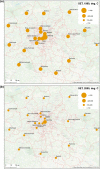Re-introduction of vivax malaria in a temperate area (Moscow region, Russia): a geographic investigation
- PMID: 32188468
- PMCID: PMC7081549
- DOI: 10.1186/s12936-020-03187-8
Re-introduction of vivax malaria in a temperate area (Moscow region, Russia): a geographic investigation
Abstract
Background: Between 1999 and 2008 Russia experienced a flare-up of transmission of vivax malaria following its massive importation with more than 500 autochthonous cases in European Russia, the Moscow region being the most affected. The outbreak waned soon after a decrease in importation in mid-2000s and strengthening the control measures. Compared with other post-eradication epidemics in Europe this one was unprecedented by its extension and duration.
Methods: The aim of this study is to identify geographical determinants of transmission. The degree of favourability of climate for vivax malaria was assessed by measuring the sum of effective temperatures and duration of season of effective infectivity using data from 22 weather stations. For geospatial analysis, the locations of each of 405 autochthonous cases detected in Moscow region have been ascertained. A MaxEnt method was used for modelling the territorial differentiation of Moscow region according to the suitability of infection re-emergence based on the statistically valid relationships between the distribution of autochthonous cases and environmental and climatic factors.
Results: In 1999-2004, in the beginning of the outbreak, meteorological conditions were extremely favourable for malaria in 1999, 2001 and 2002, especially within the borders of the city of Moscow and its immediate surroundings. The greatest number of cases occurred at the northwestern periphery of the city and in the adjoining rural areas. A significant role was played by rural construction activities attracting migrant labour, vegetation density and landscape division. A cut-off altitude of 200 m was observed, though the factor of altitude did not play a significant role at lower altitudes. Most likely, the urban heat island additionally amplified malaria re-introduction.
Conclusion: The malariogenic potential in relation to vivax malaria was high in Moscow region, albeit heterogeneous. It is in Moscow that the most favourable conditions exist for vivax malaria re-introduction in the case of a renewed importation. This recent event of large-scale re-introduction of vivax malaria in a temperate area can serve as a case study for further research.
Keywords: Autochthonous cases; Climate favourability; Environmental determinants; Geospatial analysis; Modelling; Re-introduction; Vivax malaria.
Conflict of interest statement
The authors declare that they have no competing interests.
Figures










References
-
- Beljaev AE, Rybalka VM, Lysenko AJ, Abrashkin-Zhuchkov RG, Alekseeva MI, Arsenyeva LP, et al. Plasmodium vivax: further observations on polymorphism in relation to the duration of exo-erythrocytic development (In Russian). In Malaria Parasites of Mammals; Academy of sciences of the USSR Protozoology series; Leningrad: Nauka; 1986: 11; 40–157. (In Russian).
-
- Lindsay S, Joyce A. Climate change and the disappearance of malaria from England. Global Change Hum Health. 2000;1:184–187. doi: 10.1023/A:1010073211753. - DOI
-
- Bruce-Chwatt LJ, de Zulueta J. The rise and fall of malaria in Europe. A historico-epidemiological study. London: Oxford University Press; 1980.
MeSH terms
Grants and funding
LinkOut - more resources
Full Text Sources

